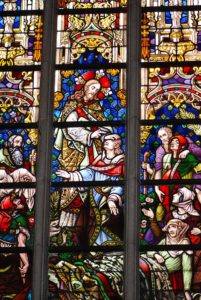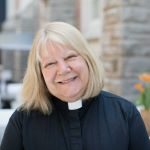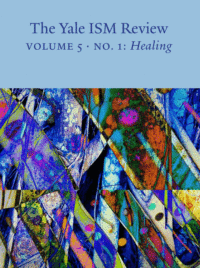Lizette Larson-Miller
Even a casual reading of the canonical gospels reveals that much of Jesus’s ministry was devoted to healing. His healing was of physical ailments (the woman with the hemorrhage, Mark 5:21–24)[1], or mental and spiritual ailments (“Jesus went about curing every disease and every sickness,” Matthew 4:23–24). He cured disabilities, such as the man born blind (John 9:1–12), as well as social maladies (the woman “caught in adultery,” John 8:3–11). Healing—making whole—was never an end in itself, but rather a means by which Christ led that person to resurrection and life (salvation). It was a sign of the reign of God begun. In all of the examples handed down to us, healing was a means to an end, as it always pointed to the presence and power of God.
The healings recounted in the gospels might remain simply stories of what Jesus did long ago and far away, except that the body of Christ, the Church, is formed through the birth, life, death, resurrection, and glorification of Christ, and born into all of that through the waters of baptism. The Church is charged with the command to continue the work he began—to “do this” until Christ returns: “Go therefore and make disciples of all nations, baptizing them in the name of the Father and of the Son and of the Holy Spirit.” (Matthew 28:19).

Stained glass depiction from St. Baavo Cathedral in Ghent of Jesus healing the sick. Photo by Thomas Quine.
To be a disciple—or perhaps better, an apprentice—is not primarily to learn a teaching that is external to one’s own being, but to pattern one’s life on the teaching, and imitate the actions, of the Rabbi. What may begin with a deep knowing (“let the same mind be in you that was in Christ Jesus. . .” Philippians 2:5) is rehearsed and embodied socially, kinesthetically, emotionally, spiritually, and mentally. “Then Jesus called the twelve together and gave them power and authority over all demons and to cure diseases, and he sent them out to proclaim the kingdom of God and to heal” (Luke 9:1–2). A chapter later in Luke, the charge to the original twelve followers is expanded to include others, an expansion that continues through the centuries to all those made disciples through baptism. “After this, the Lord appointed seventy others and sent them on ahead of him in pairs to every town and place where he himself intended to go. . .” “He told them “Whenever you enter a town and its people welcome you, eat what is set before you; cure the sick who are there, and say to them, ‘The kingdom of God has come near to you.’” (Luke 10:1, 8–9). And so the Church proclaims healing and the presence of the kingdom of God in words and deeds until Christ comes again. But how does the Church do that?
The primary New Testament text and description of the early Church’s care for the sick is embedded in the letter of James:
Is anyone among you sick? Let them call the elders of the church to pray over them and anoint them with oil in the name of the Lord. And the prayer offered in faith will make the sick person well; the Lord will raise them up. If they have sinned, they will be forgiven. (James 5:14–15)
The author of the letter of James gathered together three fundamental ecclesial practices—tools of healing—by which the Church would minister with and to the sick. The first is prayer, which is attested to in scripture and early Christian writing as the obligation of all Christians. But here, it is not prayer spoken at a distance: it is prayer “over” the sick, which joins prayer to the second fundamental ecclesial practice, the laying on of hands. Many years ago, Godfrey Diekmann suggested that the laying on of hands was the fundamental gesture or action for the communication of God’s presence in ritual and sacrament. He wrote that the “laying on of hands, understood as a conferring of the Holy Spirit, constituted in early Christianity the basic liturgical rite common to all the sacraments. In other words, this ‘prayer over’ is at the heart of the Church’s prayer for the sick, the ritual by which the Holy Spirit has been brought “into the center and heart of the sacramental rites.”[2] Finally, the letter includes a third element in the work of healing through the Church, and that is anointing with oil. All three of these—spoken prayer, laying on of hands, and anointing with oil—are forms of prayer. But how did anointing with oil become central to healing within the first century of Christianity, eventually becoming the primary ritual matter and action that gave its name to the sacrament of the sick?

Like many physical or ritual dimensions of sacramental celebrations, oil has a long history of biblical, cultural, and Christological associations that contribute to its centrality. Scripture describes oil used for various ritual and practical purposes, from simple cooking oil to the best of fresh oil used for offerings and exchanges, to scented oil mixed with expensive perfumes and spices used to set apart places and mark persons as holy.[3] In the New Testament, anointing with oil is described in two different ways: first as a pouring over someone, and second as an anointing that effects a transformation of identity in someone. The second use of anointing with oil is connected to the identification of Jesus as the Christed or anointed One, and is linked to the Church’s ongoing use of chrism. On the other hand, the oil of healing emerges from the term for the pouring out of oil, as seen in James 5 and in Mark 6:13 (“So they [the apostles] went out and preached that all should repent. And they cast out many demons and anointed with oil many that were sick and healed them.”) Culturally, especially in the climates around the Mediterranean Sea where Christianity was born, the natural healing properties of oil as an external unguent on the skin and on injuries, as well as the internal use of oil added as a medication or supplement to the diet, had already been well-recognized as an agent of healing long before the Christian adaptation of oil in sacramental practice.[4]
From here the Church begins a long history of setting olive oil aside through an episcopal blessing so that it is recognized as both effecting a strengthening of the individual and being an action of the whole Church, because the bishop was the primary ecclesial symbol of the Church’s unity. This oil is described in numerous stories throughout the first millennium of Christianity as being used by any of the baptized on any of the baptized as long as it was “confected” by the bishop.[5] The key is to distinguish between the healing by a charismatic individual, a tradition already evident in the Apostle Paul’s writing, and the healing office of the Church with its sacramental efficacy, regardless of who was doing the anointing.
In the ninth to eleventh centuries, the specific task of spiritual healing (forgiveness of sins) began to supersede that of all other healings, particularly physical healing.
The healing described in the letter of James is holistic: those who are sick will be healed and their sins will be forgiven. James makes clear that health—wholeness—is about strengthening and enabling the sick to cope with the ramifications of illness, whether these be physical or spiritual. Throughout medieval Western church developments, anointing was part of a larger set of practices which gradually grew more and more elaborate, and included the laying on of hands, communion, psalms, and scripture readings. In the ninth to eleventh centuries, the specific task of spiritual healing (forgiveness of sins) began to supersede that of all other healings, particularly physical healing. As this sacramental emphasis mixed with the changes in the sacrament of reconciliation, the anointing with oil became not so much a holistic and physical healing but a spiritual healing at the end of life. It became a sacrament of the dying. Scholastic theologians placed viaticum (one’s last communion) at the center of the final rites for the dying. These rites were re-ordered so that the anointing came last, in extremis, hence the term “extreme unction.” In Roman Catholic tradition this sacramental practice endured until the 1970s when the rite was reformed after the Second Vatican Council.
The return to a sacramental rite for the sick—and a holistic healing that points to the reign of God—has emerged over the past fifty years in many ecumenical circles. There was, for example, some thinking in Anglicanism along these lines at the beginning of the twentieth century, as a counter to the rise in spiritualism and various practices denying the importance of the Incarnation.[6] But official rituals emerged primarily from the work of Vatican II:
“Extreme unction,” which may also and more fittingly be called “anointing of the sick,” is not a sacrament for those only who are at the point of death. Hence, as soon as any one of the faithful begins to be in danger of death from sickness or old age, the fitting time for him to receive this sacrament has certainly already arrived.[7]
The sick exercise a ministry to the larger Church by their witness of faith in Christ.
As similar sets of rituals have emerged in different churches, several key theological ideas have been more clearly articulated in recent decades. The first is to clarify the difference between curing and healing. Physical illness may be healed, since all things are possible for God, but even if an immediate cure is not apparent to the human eye, a sacramental healing has occurred, since “sacraments always work.”[8] This points to an essential distinction between curing an illness and healing the whole person. The Church’s ministry to the sick is to strengthen and restore relationships with God, community, and self; to overcome isolation, give hope and strength, and to know oneself in the love and mercy of God. The sick exercise a ministry to the larger Church by their witness of faith in Christ. They bear this witness both through their participation in the life and the suffering of Christ, and by praying for others from that position of greater knowing in Christ. The second clarification is to reiterate the difference between charismatic healing—the gift of healing given to an individual directly by God—and the healing office of the Church. Ecclesial communities have recognized the authority to anoint the sick based on different interpretations of James, some limiting the ministry to those in holy orders (deacons and priests or priests alone), and others to any of the baptized with suitable preparation. Above all, the blessing of the oil by the bishop (usually at an annual Chrism Mass) remains important for the ecclesial nature of the ministry and its sacramental efficacy. Third, recent decades have seen a growing understanding of the complexity of the human person. Using the insights of Christian anthropology, humans are understood not simply as dualistic (body and spirit), but psycho-social-somatic-spiritual beings for whom healing may mean social, emotional, and mental healing as much as physical and spiritual healing. The result is seen in expanded language of prayer and more frequent opportunities for the anointing of the sick.
“Is anyone among you sick? He should summon the presbyters of the church, and they should pray over him and anoint with oil in the name of the Lord, and the prayer of faith will save the sick person, and the Lord will raise him up.”[9]

 The Rev. Canon Lizette Larson-Miller, PhD, is the Huron-Lawson Professor of Liturgy at Huron University College (University of Western Ontario). She is the author of numerous articles and books on the study of sacramentality and sacraments, especially on the rites with the sick and the dying. Her most recent book was Sacramentality Renewed, published by Liturgical Press. In addition, she serves as the liturgical officer for the diocese of Huron (in the Anglican Church of Canada), as well as on the editorial board of several journals internationally.
The Rev. Canon Lizette Larson-Miller, PhD, is the Huron-Lawson Professor of Liturgy at Huron University College (University of Western Ontario). She is the author of numerous articles and books on the study of sacramentality and sacraments, especially on the rites with the sick and the dying. Her most recent book was Sacramentality Renewed, published by Liturgical Press. In addition, she serves as the liturgical officer for the diocese of Huron (in the Anglican Church of Canada), as well as on the editorial board of several journals internationally.[1] Unless otherwise noted, all quotations of scripture are taken from the New Revised Standard Version.
[2] See Godfrey Diekmann, “The Laying on of Hands: The Basic Sacramental Rite” CTSA Proceedings 29 (1974), 349–50.
[3] See J. Roy Porter, “Oil in the Old Testament” in The Oil of Gladness: Anointing in the Christian Tradition, ed. Martin Dudley & Geoffrey Rowell. (London: SPCK, 1993).
[4] Olive oil was a primary market commodity used for eating, drinking, light, healing, and more. For a spirituality based on all of these, see the beautiful hymns of Ephrem the Syrian, particularly his fourth hymn on Virginity (see Kathleen McVey, Ephrem the Syrian: Hymns (New York: Paulist Press, 1989).
[5] It was episcopal consecration that gave the “ecclesial virus” to the oil, making the anointing an action of the whole Church. That was the standard practice, but there are also examples in the first millennium of oil run through the tombs of martyrs and other saints as an alternative act of “consecration.”
[6] See Charles W. Gusmer, The Ministry of Healing in the Church of England, an Ecumenical-Liturgical Study. (Essex, Great Britain: The Alcuin Club, 1974) 10–20.
[7] Sacrosanctum Concilium 73, http://www.vatican.va/archive/hist_councils/ii_vatican_council/documents/vat-ii_const_19631204_sacrosanctum-concilium_en.html
[8] Thomas Talley, “Healing: Sacrament or Charism?” in Reforming Tradition (Washington, DC: The Pastoral Press, 1990), 49.
[9] James 5:14–15, New American Bible, Revised Edition (NABRE).
—
This material is licensed under an Attribution-NonCommercial 4.0 International License.
Recommended Citation: Larson-Miller, Lizette (2019): “The Church’s Work of Healing: Prayer, Laying on of Hands, and Anointing,” The Yale ISM Review: Vol. 5: No. 1, Article 6. Available at https://ismreview.yale.edu
